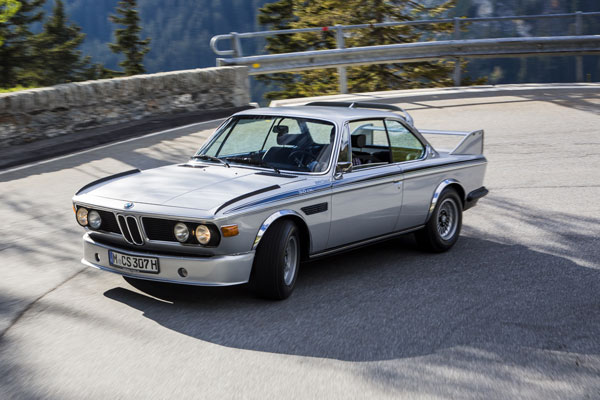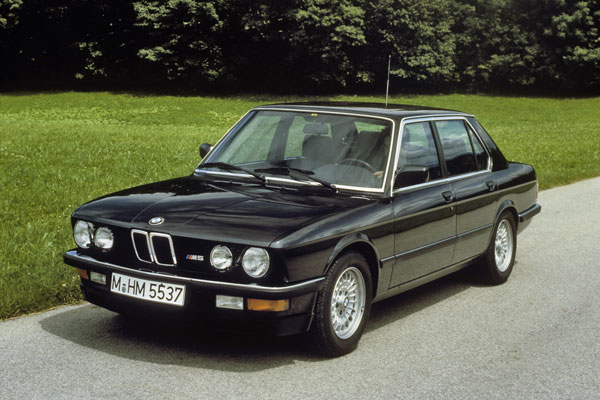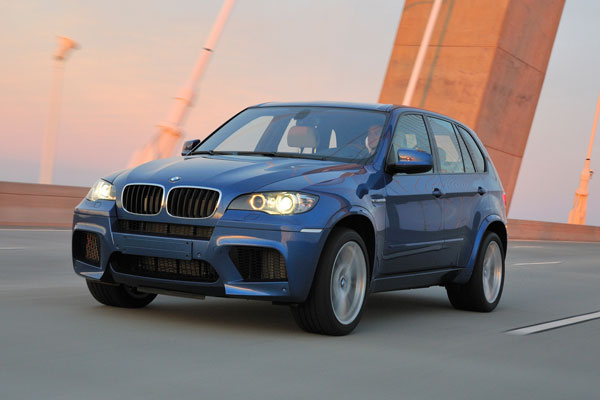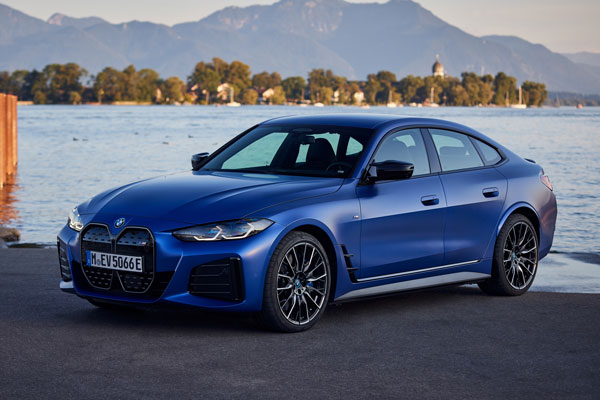50 Years of the BMW M
Over the past few months, BMW has revealed a heap of exciting new cars. Since January, the German manufacturer has unveiled the new 7 Series as well as the all-electric iX M60 SUV; the M8 Competition Coupe, Cabriolet, and Gran Coupe; and special editions of the M4 CSL, M3 and M4. It has also given a taste of the upcoming XM uber-performance SUV. There have been plenty of others too.
Many of these models fall under the M banner, with the M4 CSL, amongst others, being special editions that mark a
milestone anniversary for the division that is home to the most potent models of the BMW stable.
In fact, 2022 marks the 50th anniversary of BMW M, a brand that has long been – along with rivals such as AMG at Mercedes – the benchmark for luxury, high-performance cars.
With that in mind, in this edition of Motor Trader, we take a quick look at the history of BMW M, and some of the storied cars that have made the brand the legend it is.
THE M STORY
Initially created to oversee BMW’s motor racing program, BMW M was founded as BMW Motorsport GmbH in 1972. A handful of engineers and others formed the core of the new company and its work in the first few years was marked by its development of racing cars, in particular the phenomenal and highly successful 3.0 CSL.
Conceived as a homologation special for touring car racing in Europe, the 3.0 CSL was based on the 3.0 CS and 3.0 CSi coupe, but its emphasis on weight reduction (the ‘L’ stood for Leicht or Light), aerodynamics, suspension, and power, made it something special.
Power came from the straight-six, 3-litre, M30 engine, tweaked versions of which were used throughout the model’s production life and which, in the last variant of the CSL – known as the ‘Batmobile’ – was good for 153kW and 286Nm. The ‘Batmobile’ sported some interesting aerodynamic styling, including small fins that ran along the top of the front wings, and a whopper of a rear wing that, thanks to German regulations of the time, was not factory installed but could be fitted by the owner. It was powerful, slick and quick, and racing versions of it were dominant on the track. Produced through to 1975 with just over 1200 units made, the CSL was a great way for the fledgling M division to introduce itself as a premiere performance brand.
As good as the CSL was – and it was a cracker – BMW Motorsport hit an even sweeter high note with its 1978 creation, the mid-engine M1 supercar.
Once again, the car was built with racing in mind, and was available as a road-going model thanks to homologation rules for the racing category at which it was aimed.
Under the fibreglass body, which helped the car to weigh in at a trim 1300kg, was a 3.5-litre, naturally aspirated, six-cylinder powerplant that delivered 204kW and 330Nm. This could push the sleek machine to a top speed of 265km/h – the fastest road-legal German sports car of the time.
Production of the M1 was short and ran from 1978 to 1981 with just 455 units being built – 399 for the road and 56 for the track. Not surprisingly, it is now considered a dead-set classic.
It was in the 1980s that BMW M really found its feet as the maker of top-quality high-performance road cars. This was the decade that saw the emergence of the 3, 5, and 6 series M cars.
First up was the M635CSi, (known as M6 in the US).
Unveiled at the 1983 Frankfurt Motor Show, the elegant two-door coupe was powered by an upgraded version of the 3.5-litre, six-cylinder, M88 engine that powered the M1, and had 213kW and 340Nm at its disposal. 100km/h could be reached in less than 6.5 seconds and top speed was 255 km/h, making it one of the fastest four-seater cars of the period. BMW M’s trademark revisions to suspension and chassis made the M635CSi a comfortable but formidably potent machine and, while it was expensive, some 5,500 were sold during its five-year production life.
Following the M635CSi, M brought to the life the first M5 model in 1985.
The four-door M5 sedan (the E28) looked like a standard 5-series model, but under the skin was the same
engine that powered the M635CSi, plus M’s performance-enhancing amendments to suspension and braking. And that performance was red hot. A top speed of 245km/h and a 0-100km/h time of 6.5 seconds made it the fastest production sedan in the world at
the time.
That first variant – the E28 – was built through to 1987 and was a major critical success, but perhaps BMW M’s biggest success in those early days, was its next model, the M3, unveiled in 1986.
Though smaller than its siblings, it had outsized influence and sold well. Available as a 2+2 coupe and convertible, the first M3 (the E30) had at its heart a 2-litre, four-cylinder engine that had been given the M treatment with displacement increased to 2.3 litres. Power came in at 147kW and top speed was 235km/h.
Special edition models had that performance bumped even higher. The EVO1 from 1989 pumped out 158kW and could reach 240km/h, while the Sport Evolution model of 1990 got a 2.5-litre engine delivering 175kW for a top speed of 250km/h.
With the exterior aero and styling trimmings – including a rear wing, special alloy wheels, and the M-brand flashes and badging – the M3 looked the business and underneath, those M modifications – including stiffer springs, special shocks, and larger disc brakes – made the M3 a critical favourite. The punters loved it too, and more than 17,000 of the E30 M3s sold during its production lifetime of 1986 to 1991.
Into the 1990s, BMW M tinkered with the 5.6-litre, V12-powered 850 CSi, then brought out evolutions of the M3, M5 and M6. Engines got bigger and more powerful. The E36 M3 (made from 1992-1999) initially came with a 3-litre, six-cylinder engine before being upgraded to a 3.2-litre straight from 1995. By then, power was up to 240kW and 350Nm.
The E34 M5 (1988-1995) would grow to have a 3.8-litre six-cylinder developing 254kW and 400Nm before being fitted with a truly muscular and brutish 4.9-litre V8 pumping out 298kW and 500Nm in the E39 model (1997-2003).
Making their appearance during this period were two new models – the M Roadster and M Coupe.
The original Z3 models were powered by 1.8-litre or 1.9-litre, four-cylinder engines, but the M Roadster and Coupe versions that appeared in 1997 were equipped with the engine from the updated E36 M3. That powerful engine punched the Roadster and Coupe to 100 km/h in 5.4 seconds and on to a top speed of 250 km/h.
Wider than the standard Z3, the M Roadster and Coupe had quadruple exhausts, upgraded brakes, reinforced suspension and chassis, and additional door braces to handle the new engine’s power.
Into the new millennium, the M division kept on building better, more powerful, more luxurious and better performing cars.
The E46 M3 and M3 CSL models of the early 2000s boasted a 3.2-litre six-cylinder which the Z4M Roadster and Coupe models from 2004-2008 also received, while the M5 (E60) and M6 (E63-64) models sold through to 2010 were given a potent 5-litre V10 that developed 378kW and 520Nm.
The M3 (E90) model made from 2006-2013 would get a serious bump in grunt, with a 313kW/400Nm 4-litre V8 providing the power.
During that first decade of the new century, BMW M turned its attention to the burgeoning (and now dominant) sector of the automotive market, the SUV.
BMW had bought Britain’s Rover Group – owners of Land Rover – in 1994, and though it would sell Land Rover to Ford in 2000, it determined that an SUV was needed for its own model line-up.
BMW would ultimately launch the X5, its first SUV, in 1999. Featuring all-wheel-drive and marketed as an SAV (Sports Activity Vehicle), the X5 was available with a range of powerplants, from a 3-litre six-cylinder, to a 3-litre turbo diesel, to a 4.8-litre V8. It got a sibling of sorts in 2008 with the fastback-rear-styled X6.
M was working on creating its own versions of these two machines within a few years. It was probably just as well, as BMW’s great rivals at Porsche and Mercedes-Benz were creating, in their respective Cayenne and ML-class models, some powerful SUVs of their own.
The results of BMW M’s work was revealed at the 2009 New York motor show, with both the X5M and X6M making their debuts.
Powered by a 4.4-litre, twin turbo V8 developing 414kW and 680Nm, the M models were potent. They had all-wheel-drive, variable torque shift, torque vectoring, active roll stabilisation, and they were, of course, quick. Top speed was restricted to 250km/h (275km/h unrestricted), and they could reach 100km/h from a standstill in 4.7 seconds. That’s not the sort of performance you’d normally expect from a chunky SUV.
Through the 2010s, BMW M continued on its winning streak and turbo power finally came to the fore – BMW’s TwinPower Turbo technology found its way into just about every car, allowing smaller engines to deliver just as much, if not more more, power. For example, the M5 (F10) model built from 2010-2016 stepped down its engine size from the earlier 5-litre, V10 model and was instead powered by a 4.4-litre, twin turbo V8. That unit spat out 418kW and 680Nm – easily squashing the performance of its predecessor.
Today, of course, while turbo power is still dominant, the move to electrification has seen M, those most dedicated of internal combustion engine magicians, embrace the new technology.
While the division’s ever-expanding range of models – that runs from the small M2 two-door coupe up to the big SUVs – can come with petrol, mild hybrid, and diesel powerplants, the future appears to be filled with electrons.
Debuting in the past few months has been the i4 M50 – an all-electric powerhouse that uses a dual-motor set-up and an 83.9kWh battery pack to deliver 400kW and 795Nm – and the iX M60, an SUV which has 455kW and 1015Nm on tap from its dual-motor set-up and which can do the 100km/h sprint in 3.8 seconds and reach a top speed of 250km/h.
And an upcoming thrill for BMW M enthusiasts will be the XM SUV. A hybrid vehicle, the XM will combine a V8 engine and electric drive which is set to deliver 480kW and 800Nm. Performance will be stellar, but it may be the fact this is a standalone vehicle built by M and not a modified ‘standard’ BMW, that will make it stand out from the crowd.
Whatever happens, it would be a safe bet that in a world in which electrification becomes the standard, the M division will be as important a name on the performance-vehicle landscape as it has ever been.
Source: Motor Trader e-Magazine (June 2022)
9 June 2022















